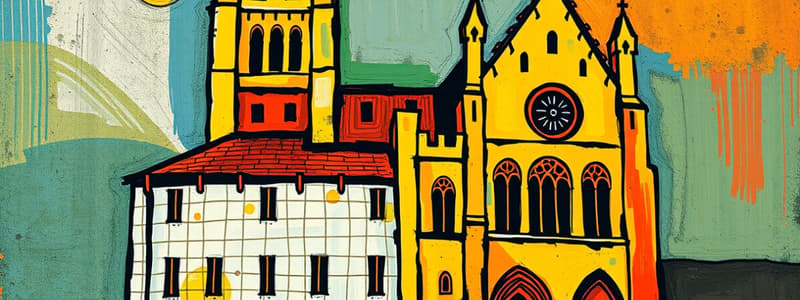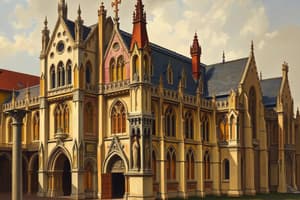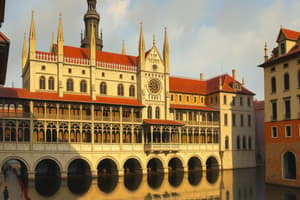Podcast
Questions and Answers
Medieval architecture primarily developed in Asia between the 5th and late 15th century.
Medieval architecture primarily developed in Asia between the 5th and late 15th century.
False (B)
The Gothic style of architecture is characterized by pointed arches and ribbed vaults.
The Gothic style of architecture is characterized by pointed arches and ribbed vaults.
True (A)
Flying buttresses are exclusively found in Renaissance architecture.
Flying buttresses are exclusively found in Renaissance architecture.
False (B)
Small windows are a characteristic feature of Romanesque architecture.
Small windows are a characteristic feature of Romanesque architecture.
The Tower of London is an example of a Gothic cathedral.
The Tower of London is an example of a Gothic cathedral.
Stained glass windows are typically associated with the Romanesque architectural style.
Stained glass windows are typically associated with the Romanesque architectural style.
Castles served both military and residential purposes during the medieval period.
Castles served both military and residential purposes during the medieval period.
The use of ribbed vaults allowed for shorter structures in medieval architecture.
The use of ribbed vaults allowed for shorter structures in medieval architecture.
Flashcards are hidden until you start studying
Study Notes
Overview of Medieval Architecture
- Time Period: Roughly 5th to late 15th century.
- Regions: Predominantly Europe.
Key Styles
-
Romanesque (circa 800-1100)
- Characterized by:
- Thick walls and pillars.
- Round arches and barrel vaults.
- Small windows, creating a dimly lit interior.
- Notable Examples:
- St. Sernin, Toulouse.
- Durham Cathedral, England.
- Characterized by:
-
Gothic (circa 12th-16th century)
- Key Features:
- Pointed arches and ribbed vaults.
- Flying buttresses for support.
- Larger windows with stained glass.
- Ornate decoration and sculptures.
- Notable Examples:
- Notre-Dame de Paris.
- Chartres Cathedral.
- Key Features:
Structural Components
- Vaults: Arches that form ceilings or roofs (barrel, ribbed, and fan vaults).
- Buttresses: External supports that help distribute weight (flying buttresses in Gothic style).
- Columns and Pillars: Vertical supports, often decorated with carvings.
- Windows: Often stained glass in Gothic architecture, depicting biblical stories.
Construction Techniques
- Materials: Primarily stone, brick, and later, timber.
- Masonry: Techniques evolved to improve strength and stability.
- Innovations: Use of ribbed vaults and flying buttresses allowed for taller structures.
Important Structures
- Cathedrals: Central to Christian life, serving as both worship spaces and community centers.
- Castles: Fortified structures, utilized military and residential purposes (e.g., the Tower of London).
- Monasteries: Centers of learning and preservation of texts (e.g., Cluny Abbey).
Cultural Significance
- Religious Influence: Architecture was heavily influenced by the Church; buildings often reflected spiritual devotion.
- Socio-Political Role: Castles and fortifications symbolized power and control.
- Artistic Expression: Elaborate sculptures and carvings were used to convey religious stories and local culture.
Legacy
- Transition to Renaissance: Shift in architectural styles with a focus on symmetry, proportion, and classical influences.
- Preservation: Many medieval structures remain significant cultural and historical landmarks today.
Overview of Medieval Architecture
- Time span from the 5th to late 15th century, marking significant design evolution in Europe.
- Dominance in European regions, reflecting various cultural and religious influences.
Key Styles
-
Romanesque (circa 800-1100)
- Characterized by robust construction: thick walls and towering pillars.
- Use of round arches and barrel vaults, creating a distinctive archway structure.
- Small windows contribute to a darker, more introspective interior atmosphere.
- Notable examples include St. Sernin in Toulouse and Durham Cathedral in England.
-
Gothic (circa 12th-16th century)
- Distinguished by pointed arches and intricate ribbed vaults for aesthetic appeal and structural support.
- Incorporates flying buttresses to distribute structural weight, allowing for an elevated design.
- Features larger windows filled with vibrant stained glass, enhancing interior luminosity.
- Notable examples: Notre-Dame de Paris and Chartres Cathedral, showcasing elaborate detailing and scale.
Structural Components
- Vaults: Varieties include barrel, ribbed, and fan vaults, serving both functional and decorative purposes.
- Buttresses: External structures, particularly flying buttresses in Gothic architecture, enhance stability.
- Columns and Pillars: Serve as vertical supports, often ornate with carvings that depict religious or cultural narratives.
- Windows: Stained glass commonly used in Gothic constructions, illustrating biblical stories and aiding in community storytelling.
Construction Techniques
- Primary materials consisted of stone, brick, and, in later periods, timber for more complex designs.
- Advancements in masonry enhanced the strength and stability of structures.
- Innovations like ribbed vaults and flying buttresses facilitated taller and more intricate buildings.
Important Structures
- Cathedrals: Central hubs for Christian worship and community gatherings, symbolizing spiritual significance.
- Castles: Fortified structures that served both military and residential functions, such as the iconic Tower of London.
- Monasteries: Key centers for learning and the preservation of texts, exemplified by institutions like Cluny Abbey.
Cultural Significance
- Architecture heavily influenced by the Church, marking the era with a strong sense of spiritual devotion.
- Castles served as manifestations of socio-political power, representing control and authority across regions.
- Use of detailed sculptures and carvings in buildings provided means of artistic expression and cultural storytelling.
Legacy
- Transition to the Renaissance marked a shift to styles prioritizing symmetry, proportion, and classical motifs.
- Many medieval structures preserved today serve as crucial cultural and historical landmarks, reflecting architectural heritage.
Studying That Suits You
Use AI to generate personalized quizzes and flashcards to suit your learning preferences.




